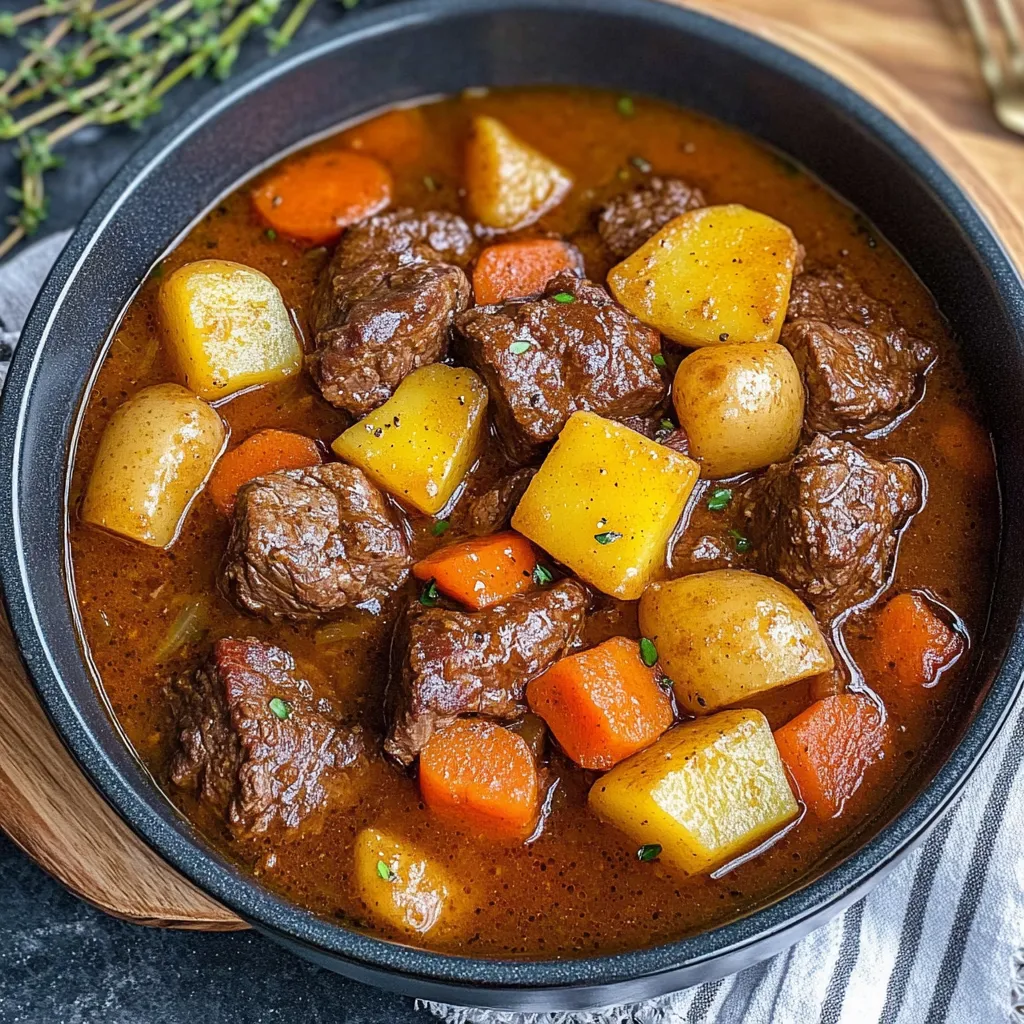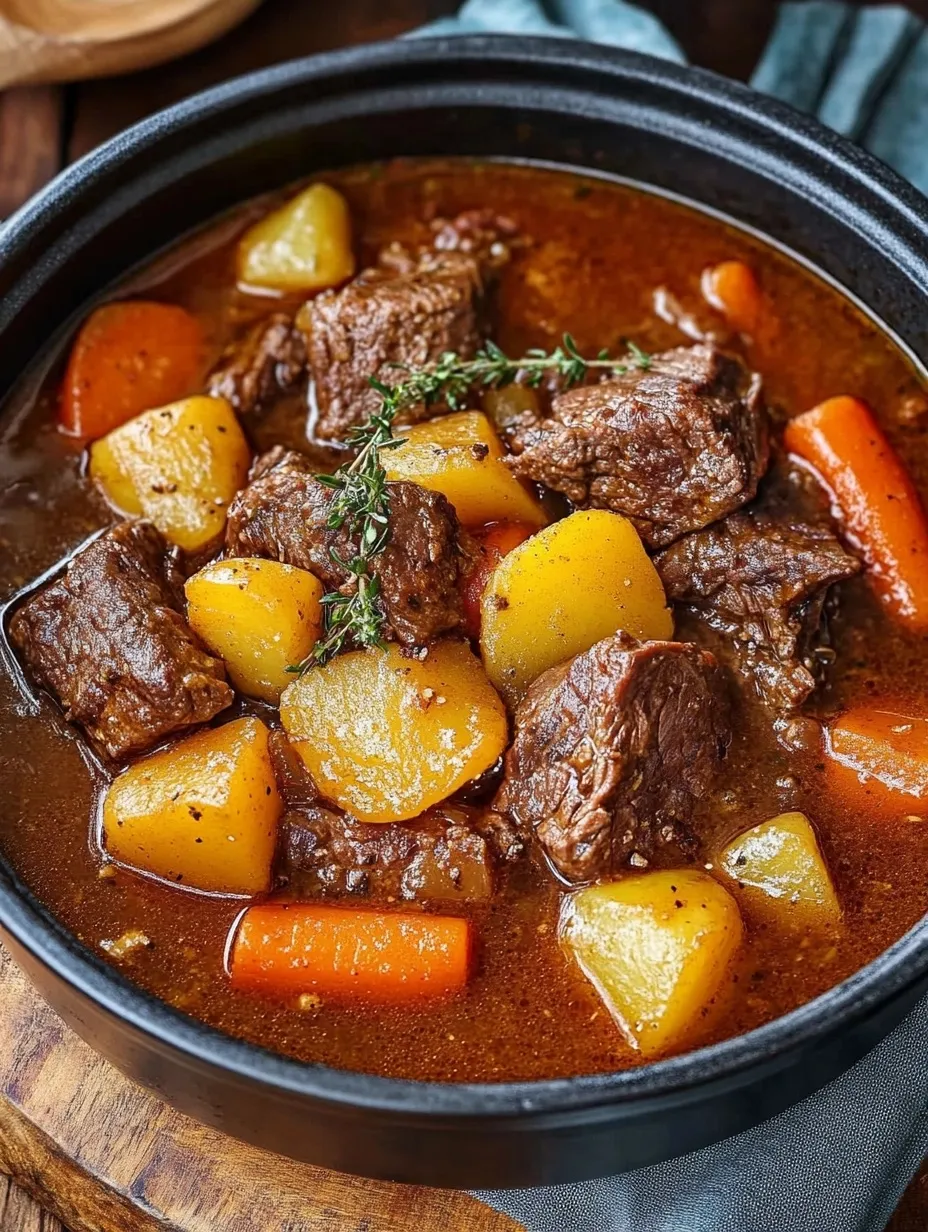 Save
Save
This dish has seen me through more chilly nights than I can count. Back when I needed something to do with a tough chuck roast, I landed on this. It's become the thing I crave most when the weather turns cold. Every bite of beef is so soft you barely need a fork, and the sauce gets insanely good from slow cooking—totally different from anything quick. Plus, while it's bubbling away, your place fills with the coziest, savory smells. Feels like a hug from your favorite blanket.
Last year, I brought some of this over to my neighbor when she was laid up after surgery. A couple days later, her husband popped by with the empty pot and begged me to jot down how I made it, saying they’d never had a stew this good. I’ve played around with little tweaks over time, and I finally feel like I nailed the exact flavors and textures I want.
Irresistible Ingredients
- Worcestershire sauce: gives it that savory oomph that makes folks wonder what you slipped in
- Tomato paste: brings a deep, rich flavor and helps the sauce get just thick enough without extra flour
- Fresh garlic: makes everything way tastier—trust me, skip the powder
- Yukon gold potatoes: hold together way better than russets, which kind of break down too much
- Chuck roast: always gets the most tender and flavorful after a long, slow cook—I've tried others, but keep running back to this one
Getting a solid brown crust on your beef at the beginning is everything—do not hurry. I used to cram all the meat in at once, but then it would just get steamed instead of browned. Now, I work in small batches for that beautiful golden crust, which really steps up the flavor in the end.
 Save
Save
Simple Method
- Last steps:
- When it’s done, very carefully grab the pot from the oven (it’s seriously hot and heavy!). Find and toss the bay leaf—nobody wants to bite into that. Taste it and add more salt, pepper, or a splash of Worcestershire if you want it bolder. Then let it sit for about ten minutes so everything can soak up even more flavor before you dish it out.
- Long slow simmer:
- Bring your pot up to a gentle bubble on the stovetop. Pop in the browned beef chunks (make sure to add any of that good juice that collected on the plate). Stir, slap the lid on tight, and slide the whole thing into your preheated oven. Now the hard part—leave it alone for 2 to 2 1/2 hours. I check once about halfway through and give it a stir. If it's looking a bit dry, just pour in another splash of broth. The meat’s ready when it’s super tender and falls apart, but doesn’t completely dissolve.
- Broth comes together:
- Drop in your potato pieces, pour over beef broth, then add Worcestershire, thyme, bay leaf, and tomato paste. Scrape the bottom of the pot with a wooden spoon so nothing gets left behind. Mix things up until the tomato paste’s dissolved. It’ll seem pretty thin at first, but don’t stress—it’ll turn delightfully thick while it cooks.
- Laying the base:
- Once the meat’s out and set aside, toss in the onions, carrots, and garlic. The veggies help pull up all those flavorful browned spots as you stir. Let them cook for a few minutes so the onions get soft and pick up some color. It’s better to hold off on adding potatoes ‘til later so they don’t get mushy.
- The browning dance:
- Pour a big splash of olive oil into a sturdy Dutch oven and heat until it’s shimmery. Pop a layer of beef in (give them space!) and let them do their thing until they form a dark brown crust, then flip to brown the other sides. Takes just three or four minutes a batch. Fish the finished pieces out and stack them on a plate as you go—don’t try to cook them all the way through. The bottom of your pan might look like a mess, but don’t clean it! That’s where the gold lives.
- Getting prepped:
- Start by firing up your oven to 325°F. While it warms, chunk your chuck roast into pieces about two inches big—it’s the perfect size for staying juicy. Trim off just the big hunks of fat, but leave a little for flavor. Hit every side with a serious dusting of salt and pepper, then toss the meat in flour until it’s covered. Don’t skip the flour, or you’ll end up with runny sauce—it helps things turn silky.
My biggest kitchen flop was using a lid that didn’t fit tight—the liquid vanished, meat went tough, veggies burned … the works. I've realized a snug lid on a Dutch oven totally matters for good braising. Another trick: don’t throw the potatoes in right from the start—wait until you add the broth so they turn out just right, not mush.
Serving Ideas
Ladle this stuff into big shallow bowls and add fresh thyme if you’ve got it. Always have some hearty bread for sopping up that killer sauce. Throw together a green salad tossed with vinaigrette if you want to lighten things up—the tang goes great with the rich stew. If it’s really cold, sometimes I’ll pile it right on top of mashed potatoes for extra comfort.
 Save
Save
Fun Swaps
If you want something extra, stir in mushrooms when you add your carrots and onions. To bring a bit of a kick, sprinkle in crushed red pepper. Sometimes I pour in a little red wine with the broth for awesome depth. When I have them, I’ll drop in fresh green peas during the last few minutes. Add some grated lemon zest at the end for a pop of brightness—it really perks up all those deep flavors.
I’ve whipped up this stew for a ton of family Sundays, and it brings everyone running to the table. There’s just something about all that tender beef and cozy veggies tangled up in velvety sauce—it sort of speaks right to your soul. It does take a while, but most of it is just waiting around, which leaves you plenty of time to enjoy the smells and all the compliments once folks dig in.
Recipe FAQs
- → Could I use a slow cooker to make this dish?
- Definitely! Start by browning the meat and softening the veggies like the recipe says. Then toss it all into the slow cooker and let it cook. Go for low for 7-8 hours or high for 4-5 hours.
- → Which kind of beef works best?
- Chuck roast works great since it cooks down super tender. Bottom round, rump roast, or ready-to-use stew beef are all good options too.
- → Can I include other vegetables?
- For sure! You can put in turnips, parsnips, celery, or even peas and green beans. Add root veggies at the same time as the potatoes, but toss in peas or beans during the last thirty minutes of cooking.
- → How should I store any leftovers?
- Once it’s cooled completely, pop it into an airtight container and keep it in the fridge for up to 4 days. It often tastes better the day after since flavors mix well!
- → Is it ok to freeze this stew?
- Absolutely! It freezes great. Move it into freezer-safe containers, and it’ll keep for three months. Thaw it overnight in the fridge, then warm it up when you’re ready.
- → What should I do if the stew's too thick?
- Just add water or more beef broth a little at a time to loosen it up. Once you’ve got the thickness you like, you might want to adjust your seasonings again.
